Estimated reading time: 15 minutes
Celebrate Pride Month by exploring LGBTQ historical destinations and delve into the rich stories of the community’s past.
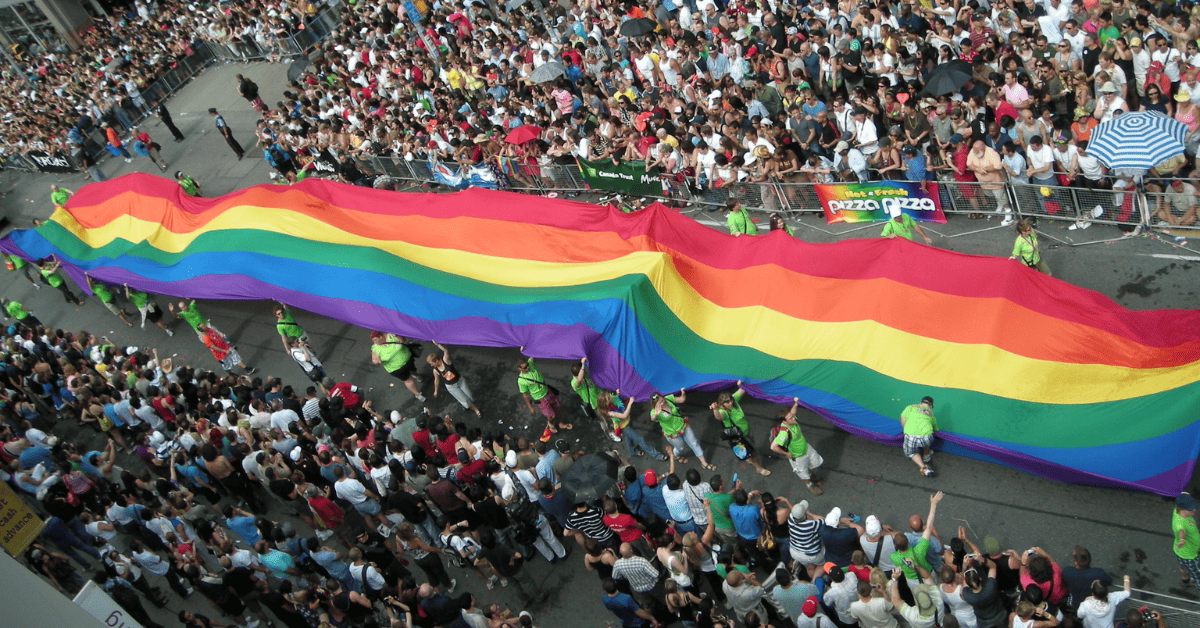
Pride Month, celebrated annually in June, is a joyous commemoration of the queer community’s achievements, struggles, and ongoing fight for equality. From historic sites that witnessed pivotal moments to cultural spaces that celebrate diversity, we invite you on a journey through LGBTQ historical destinations. Discover the stories behind iconic landmarks, learn about the struggles and triumphs of the community, and witness the indomitable spirit that has paved the way for progress and equality.
New York: Pioneering LGBTQ Historical Destinations
New York City is renowned for its iconic queer landmarks that have played a pivotal role in shaping the LGBTQ history and visibility of the community. One of the most significant landmarks in New York City’s queer scene is the Stonewall Inn. Located in the Greenwich Village neighborhood, the Stonewall Inn holds a special place as the birthplace of the modern gay rights movement. In June 1969, a series of protests and demonstrations erupted in response to a police raid at the Stonewall Inn, led predominantly by transgender women, drag queens, and people of color. This uprising, known as the Stonewall Riots or Stonewall Uprising, marked a turning point in the fight for queer rights and galvanized the formation of numerous LGBTQ+ organizations and advocacy groups.

Another notable landmark is the LGBT Community Center in Manhattan. Founded in 1983, the Center has served as a vital hub for queer individuals, offering resources, support, and community programs. It provides a safe space for various LGBTQ+ organizations and hosts events, workshops, and social gatherings that celebrate queer culture and promote inclusivity.
In the heart of the West Village, the Christopher Street Pier stands as a beloved gathering spot for queer people, offering breathtaking views of the Hudson River. It has served as a meeting place and a site of community-building for decades, attracting locals and visitors alike. The pier is a testament to the resilience and unity of the queer community, fostering connections and providing a space for expression and reflection.
Greenwich Village, in general, holds immense historical significance for the queer community. The neighborhood has been a haven for LGBTQ+ individuals, artists, and activists since the early 20th century. It is home to countless LGBTQ+-owned businesses, bars, and cafes, creating a vibrant and inclusive atmosphere. The annual NYC Pride March, held on June 25th, is one of the world’s largest Pride parades and it winds its way through the streets of Greenwich Village, showcasing the enduring spirit and diversity of the queer community.
The High Line, a converted elevated railway track turned public park, has also become an emblem of queer acceptance and celebration in New York City. The park has hosted various LGBTQ+ events, including art installations, performances, and gatherings, and has become a symbol of the city’s commitment to inclusivity and urban revitalization.

Furthermore, the Leslie-Lohman Museum of Art stands as the first LGBTQ+ art museum in the world. Located in SoHo, the museum showcases LGBTQ+ artists and their works, providing a platform for diverse voices and narratives to be seen and celebrated.
Philadelphia: A Symbol of Progress and Inclusion
Philadelphia, the birthplace of American democracy, has also played a significant role in queer history, boasting a collection of landmarks that have shaped the community’s identity, resilience, and progress.
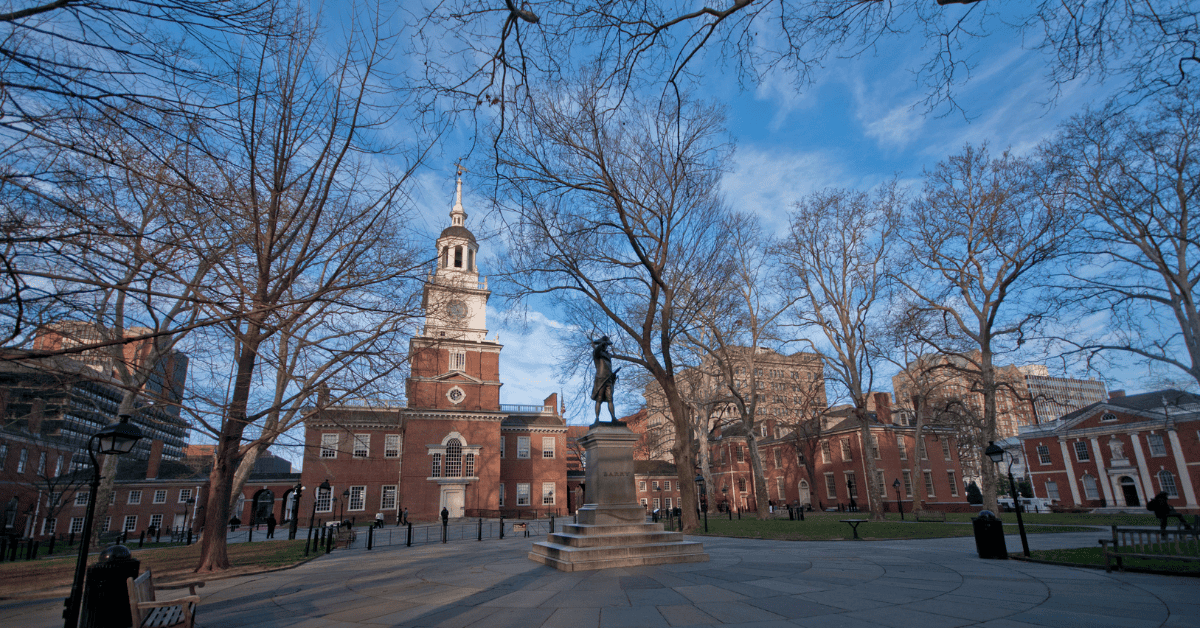
Centered around the intersection of 13th and Locust Streets, the “Gayborhood” stands as a prominent symbol in the city’s LGBTQ history. This vibrant area has been a gathering place and cultural hub for the queer community since the 1960s. The rainbow-painted crosswalks proudly mark the heart of the Gayborhood, symbolizing the community’s visibility and pride.
Philadelphia is also home to the iconic Philadelphia Pride Flag, designed by gay rights activist Gilbert Baker, the creator of the original rainbow flag. The flag includes an extra black and brown stripe to symbolize queer individuals of color, along with white, blue, and pink to represent the transgender community. This inclusive symbol of unity and diversity is proudly displayed throughout the city, including at notable landmarks like City Hall and the William Way LGBT Community Center.
The William Way LGBT Community Center itself is a crucial LGBTQ+ landmark in Philadelphia. Located in the heart of the Gayborhood, the center provides resources, support, and programming for the LGBTQ+ community. It serves as a safe space for LGBTQ+ individuals and organizations, hosting art exhibitions, cultural events, and educational workshops that celebrate LGBTQ history and culture.
Philadelphia is also home to several queer historical sites. The “Gay Pioneers” historical marker at 6th and Chestnut Streets commemorates the first organized LGBTQ+ rights demonstration in the United States, which took place in Philadelphia on July 4, 1965. This protest, led by members of the newly formed LGBTQ+ rights organization, the Mattachine Society, marked an important milestone in the fight for LGBTQ+ equality.
Another landmark is the John Fryer Memorial Statue, located outside the Pennsylvania Hospital. This statue pays tribute to Dr. John Fryer, a psychiatrist who bravely spoke out against the classification of homosexuality as a mental illness at the American Psychiatric Association’s annual meeting in 1972. His courageous act contributed to the eventual removal of homosexuality from the Diagnostic and Statistical Manual of Mental Disorders (DSM).
The Independence National Historical Park, which features the Liberty Bell and Independence Hall, also holds significance for LGBTQ history. In 2015, Independence National Historical Park became the first U.S. national park to install an interpretive panel recognizing the LGBTQ+ civil rights movement. The panel acknowledges the contributions of LGBTQ+ individuals and organizations in the ongoing struggle for equality.
San Francisco: A Place of Tribute for LGBTQ+ Persecution
San Francisco has a storied past of activism, widespread acceptance, and exuberant festivities. The city is adorned with numerous LGBTQ+ landmarks that hold deep significance in the fight for queer rights and the expression of queer identity.
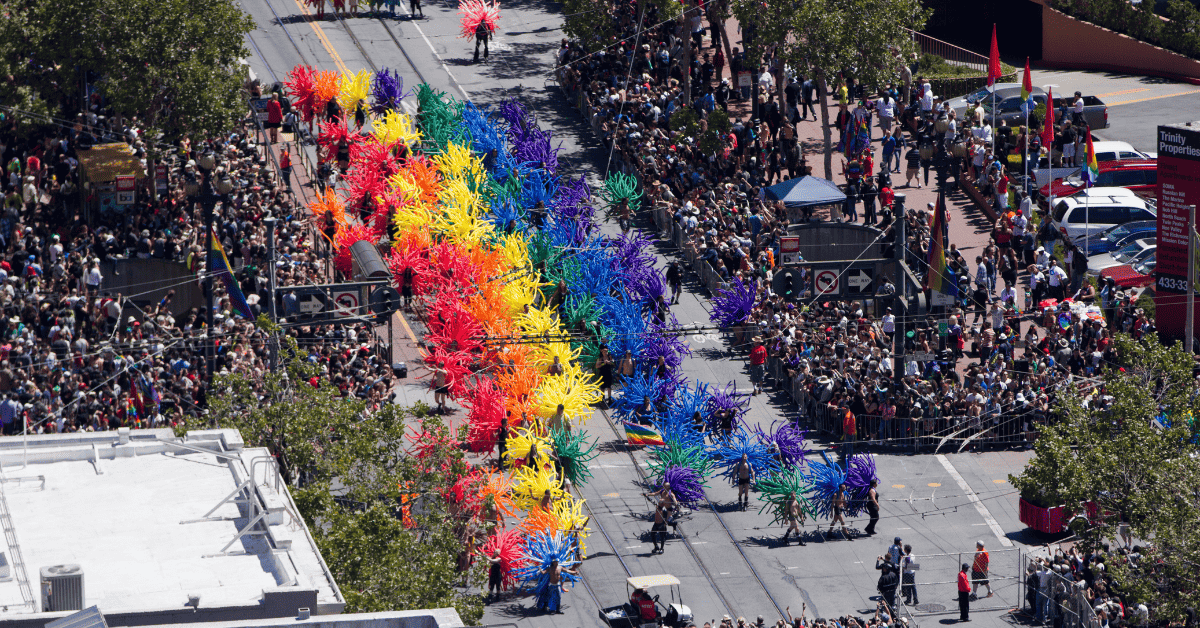
The vibrant Castro District neighborhood has been the heart of the city’s queer community since the 1960s and continues to be a symbol of LGBTQ+ visibility and pride. The rainbow flag was first raised here in 1978 by Gilbert Baker. The Castro boasts numerous queer-owned businesses, bars, clubs, and theaters, creating a lively and inclusive atmosphere where residents and visitors can connect, celebrate, and express their authentic selves.
The Castro Theatre, a historic movie palace located in the heart of the district, is another prominent LGBTQ+ landmark. It has served as a venue for LGBTQ+ film festivals, screenings, and cultural events for decades, showcasing the diversity and creativity of LGBTQ+ storytelling.
The GLBT Historical Society Museum stands as a vital institution preserving and showcasing the history of LGBTQ+ communities in San Francisco and beyond. Located in the Castro District, the museum features exhibitions, archives, and educational programs that explore the struggles, triumphs, and cultural contributions of LGBTQ+ individuals throughout history. It serves as a space for reflection, education, and celebration of queer heritage.
San Francisco’s LGBTQ+ landmarks also include places of historical importance. The Twin Peaks Tavern, for instance, holds the distinction of being the first gay bar in the United States to have clear windows, allowing passersby to see inside. This seemingly simple act challenged societal norms and became a powerful symbol of LGBTQ+ visibility and acceptance.
Another iconic landmark is the Pink Triangle Park and Memorial, situated atop Twin Peaks. This memorial pays tribute to the thousands of LGBTQ+ individuals who suffered persecution and were imprisoned during the Holocaust.
San Francisco’s annual Pride Parade and Celebration, one of the largest Pride events in the world, is yet another LGBTQ+ extravaganza. This vibrant and inclusive event draws millions of participants and spectators, filling the streets with color, music, and a spirit of love and acceptance. June 25th, 2023, marks the next edition of this iconic celebration, serving as a powerful symbol of the ongoing fight for queer rights and a joyous celebration of the community’s diversity.
London: A Pioneering Hub of LGBTQ+ Liberation and Culture
London, a diverse and dynamic global city, has a rich LGBTQ history that is reflected in its numerous landmarks. Located in the vibrant neighborhood of Soho, Admiral Duncan pub is one of the most iconic LGBTQ+ landmarks in the city. The pub has long been a gathering place for the LGBTQ+ community. Tragically, in 1999, the pub was the target of a homophobic bombing that claimed the lives of three people and injured many others. This act of violence galvanized the community and led to an outpouring of support and solidarity. Today, the Admiral Duncan stands as a symbol of resilience and defiance, embodying the spirit of London’s queer community.
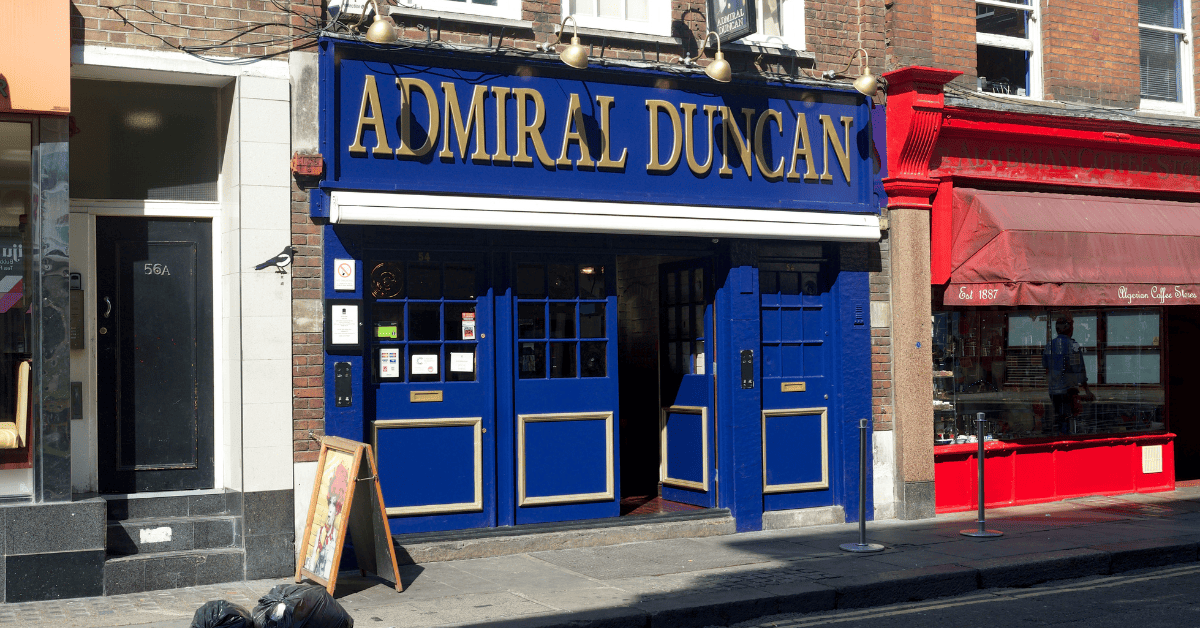
Soho itself is a historic LGBTQ+ landmark in London. For decades, this neighborhood has been a hub for LGBTQ+ social life, activism, and cultural expression. The annual Pride in London parade, one of the city’s most celebrated events, passes through the streets of Soho, showcasing the diversity and strength of the queer community. Mark your calendars for July 1, 2023 to join in the festivities.
The British Museum holds historical significance for LGBTQ history as well. It houses the famous Warren Cup, a 1st-century Roman silver drinking vessel decorated with homoerotic scenes. This precious artifact stands as a reminder of the existence and acceptance of same-sex relationships throughout history, challenging notions that LGBTQ+ identities are a recent phenomena.
The Tate Britain art gallery is home to a diverse collection of LGBTQ+ art. Its exhibitions showcase works by queer artists, exploring themes of identity, sexuality, and queer experiences. The gallery’s commitment to inclusivity and representation contributes to the visibility and appreciation of LGBTQ+ art in the cultural landscape of London.
Heathrow Airport, one of the world’s busiest airports, also holds a significant place in queer history in London. In 1993, it became the first airport in the world to host a pride event. This groundbreaking event, known as “Heathrow Pride,” marked an important turning point in the recognition and celebration of LGBTQ+ rights in public spaces.
London’s LGBTQ+ landscape encompasses a diverse range of events that have played a key role in shaping history. The enactment of the Sexual Offences Act 1967, which partially decriminalized homosexuality in England and Wales, stands as a pivotal moment in LGBTQ history. Notably, the plaque located at Highbury Fields marks the spot where the first public meeting demanding queer rights took place. These events symbolize important milestones in the ongoing struggle for equality and freedom of expression.
Amsterdam: A Timeless Beacon of LGBTQ+ Acceptance and Activism
Amsterdam, recognized for its progressive and open-minded nature, boasts a captivating queer history that is commemorated through its plethora of notable landmarks.
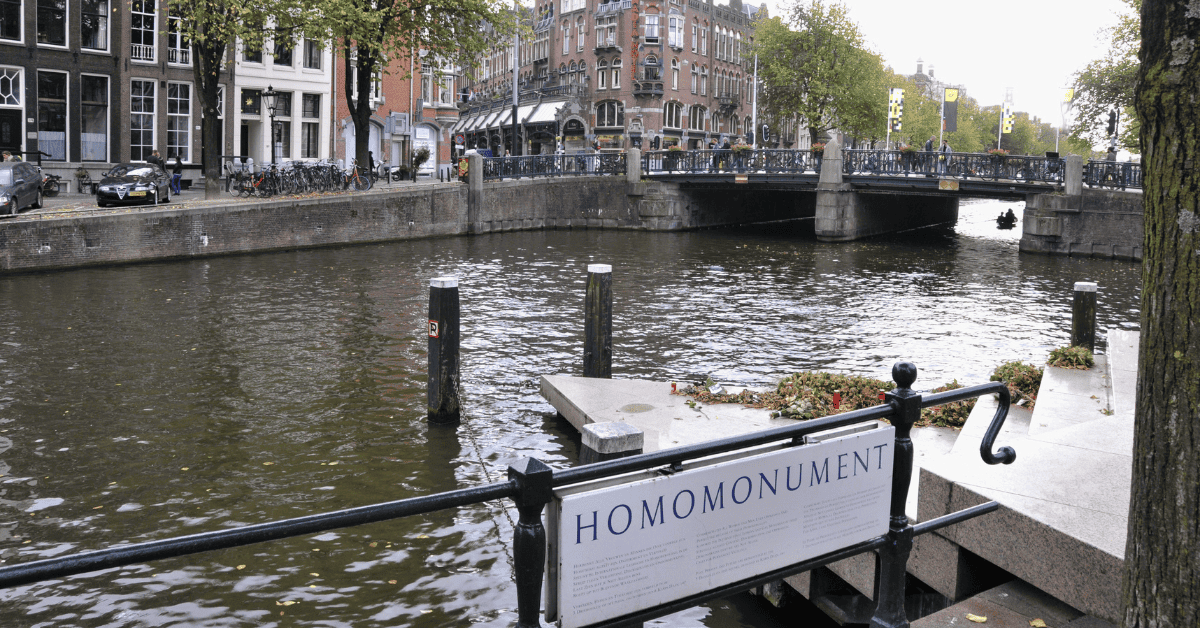
One of the most iconic LGBTQ+ landmarks in Amsterdam is the Homomonument. Located in the heart of the city, near the Westerkerk and Anne Frank House, the Homomonument is a tribute to queer individuals who have faced persecution and discrimination. Designed in the shape of three pink triangles, the monument serves as a powerful reminder of the struggles endured by the community, reflecting the city’s significant role in the gay rights movement.
The Reguliersdwarsstraat, affectionately known as “Reguliers,” is another significant LGBTQ+ landmark in Amsterdam. This lively street, located in the city center, is lined with queer-friendly bars, clubs, restaurants, and shops. Reguliers is often bustling with locals and visitors, and it serves as a hub for nightlife and socializing.
Amsterdam’s Pride celebrations are among the most renowned in the world, and they have become an iconic social event in their own right. The annual Amsterdam Pride Parade, known as the Canal Parade, takes place on the city’s historic canals, which are lined with spectators and decorated boats. Pride Amsterdam Festival lasts 9 days and takes place from July 29 to August 6, 2023, offering a vibrant celebration of pride and inclusion. The Pride celebrations extend beyond the parade, with various cultural events, parties, and conferences that celebrate LGBTQ+ culture, activism, and progress.
The Anne Frank House, a museum dedicated to the life and legacy of Anne Frank, holds historical significance for queer community. Some speculate, based on references in her writing, that Anne Frank may have had queer inclinations herself. While it remains debated, Anne’s openness and empathy towards LGBTQ+ individuals in her writing are inspiring. Visiting the Anne Frank House serves as a reminder of the shared struggles against oppression and the importance of standing up for human rights and acceptance.
Amsterdam is also home to LGBTQ+ community centers and organizations that provide support, resources, and advocacy for the queer community. These centers, such as the COC Amsterdam, serve as spaces where individuals can find a sense of belonging, engage in activism, and access various services.
Berlin: Guardian of Hirschfeld’s Legacy and the Queer Revolution
Celebrated for its dynamic and all-encompassing cultural scene, Berlin has an illustrious legacy of LGBTQ+ activism, lively nightlife, and a tightly-knit community. The city’s queer narrative is accentuated by the Schwules Museum (Gay Museum), serving as a pinnacle of recognition and preservation of queer history and culture. Founded in 1985, it is one of the world’s first museums dedicated to LGBTQ history, art, and culture. The museum’s exhibitions explore diverse aspects of queer life, activism, and identity, providing a space for education, reflection, and celebration. The Schwules Museum has been instrumental in preserving and sharing queer stories, while also hosting events and collaborations that foster community engagement and dialogue.

The Schöneberg neighborhood, particularly around Nollendorfplatz, holds historical significance for Berlin’s LGBTQ+ community. In the 1920s, Schöneberg became a thriving center of LGBTQ+ life, with lots of cafes, clubs, and gathering places. It was in this neighborhood that Christopher Isherwood, an English writer, found inspiration for his famous novel “Goodbye to Berlin,” which later became the basis for the musical “Cabaret.”
The Magnus Hirschfeld Society, also known as the Magnus Hirschfeld Center for Human Rights, pays tribute to Dr. Magnus Hirschfeld, a courageous German sexologist and gay rights activist who fought against centuries of ignorance and prejudice. Located near Nollendorfplatz subway station in Kluckstraße, the institute serves as a vibrant hub for exploring the rich history and culture of the queer community. It pioneered groundbreaking research and treatments related to gender and sexuality, including advancements in gender-affirming surgeries. Tragically, the Institute became a target of Nazi stormtroopers in 1933, resulting in the destruction of its invaluable research archives and library. However, the institute persevered, and today it houses a renowned library filled with books, journals, and archival materials that serve as invaluable resources for researchers, scholars, and those interested in queer studies. The institute also provides dedicated work rooms, fostering an environment for collaboration and the advancement of LGBTQ+ initiatives.
The Memorial to Homosexuals Persecuted Under Nazism is another significant LGBTQ+ spot in Berlin. Located in the Tiergarten park, this memorial commemorates the tens of thousands of queer individuals who were persecuted and killed during the Nazi regime. The monument, consisting of a concrete slab with a small window revealing a video installation, serves as a solemn reminder of the atrocities committed against the queer community and stands as a testament to resilience and remembrance.
Berlin’s annual Christopher Street Day (CSD) parade, one of the largest LGBTQ+ events in Europe, is a vibrant celebration of diversity, equality, and rights. The parade, named after the street in New York where the Stonewall Riots took place, fills the streets of Berlin with color, music, and a spirit of solidarity. It brings together people from all walks of life, creating a powerful sense of community and fostering visibility and acceptance. The next CSD parade in Berlin is scheduled for July 22, 2023.
The gay and queer nightlife scene in Berlin is unmatched, with several iconic venues that have become landmarks in their own right. The legendary club Berghain, known for its techno music and strict door policy, has become an internationally renowned symbol of Berlin’s queer nightlife. Other venues, such as SchwuZ, KitKatClub, and Connection, cater to a diverse range of queer identities and offer spaces for self-expression, celebration, and socializing.
Sydney: The Colorful Capital of LGBTQ Historical Destinations
The bustling capital city of Australia is home to a flourishing queer community and boasts a rich history filled with activism and joyous celebrations.
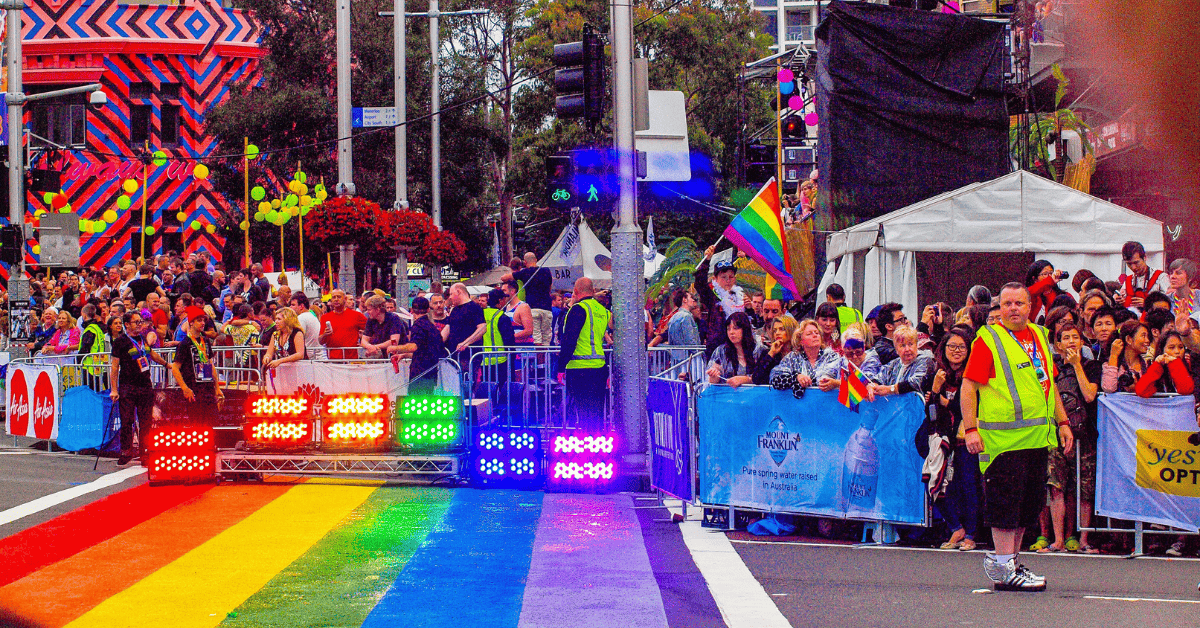
Oxford Street stands as one of Sydney’s most renowned queer spots, a vibrant thoroughfare where the community finds expression, solidarity, and pride. Located in the inner-city suburb of Darlinghurst, Oxford Street has long been the heart of the city’s LGBTQ+ community. The annual Sydney Gay and Lesbian Mardi Gras parade, one of the world’s largest LGBTQ+ events, takes place on Oxford Street, attracting millions of spectators and participants from all over the globe. This vibrant and joyous celebration of pride and culture usually spans from February to March, creating an unforgettable experience for everyone involved.
The Rainbow Crossing at Taylor Square is another significant LGBTQ+ landmark in Sydney. Located at the intersection of Oxford Street and Flinders Street, the crossing is an eye-catching display of rainbow colors. It serves as a visual symbol of LGBTQ+ pride and visibility, celebrating the city’s commitment to equality and diversity.
The Sydney Opera House, one of Australia’s most iconic landmarks, has also played a role in LGBTQ history. It has hosted numerous LGBTQ+ performances and events, including the Sydney Gay and Lesbian Choir concerts, drag shows, and queer theater productions.
The Darlinghurst Gaol, now known as the National Art School, holds historical significance for the LGBTQ+ community. In the 1970s, the prison housed many gay activists who were arrested during protests advocating for gay rights movements. Today, the National Art School stands as a reminder of the struggles faced by the community in their fight for equality and recognition.
Pride-Inspired Adventures
As summer draws near and vacation plans take shape, consider adding a touch of pride to your itinerary. Visiting these LGBTQ historical destinations not only offers a chance for exploration and discovery but also presents a unique opportunity for learning. And we are here with you at every step of your journey. Whether you need city-to-city rides, chauffeur hailing services, or airport transfers, you can rely on Blacklane for seamless and hassle-free transportation services.
